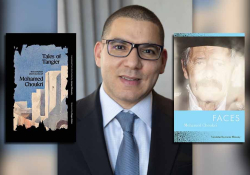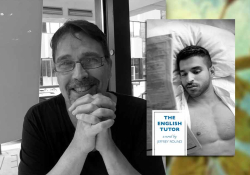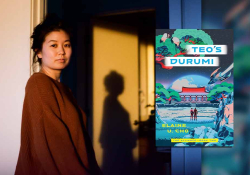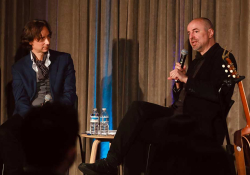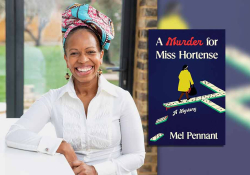A World to Be Repaired: A Conversation with Dimitris Lyacos
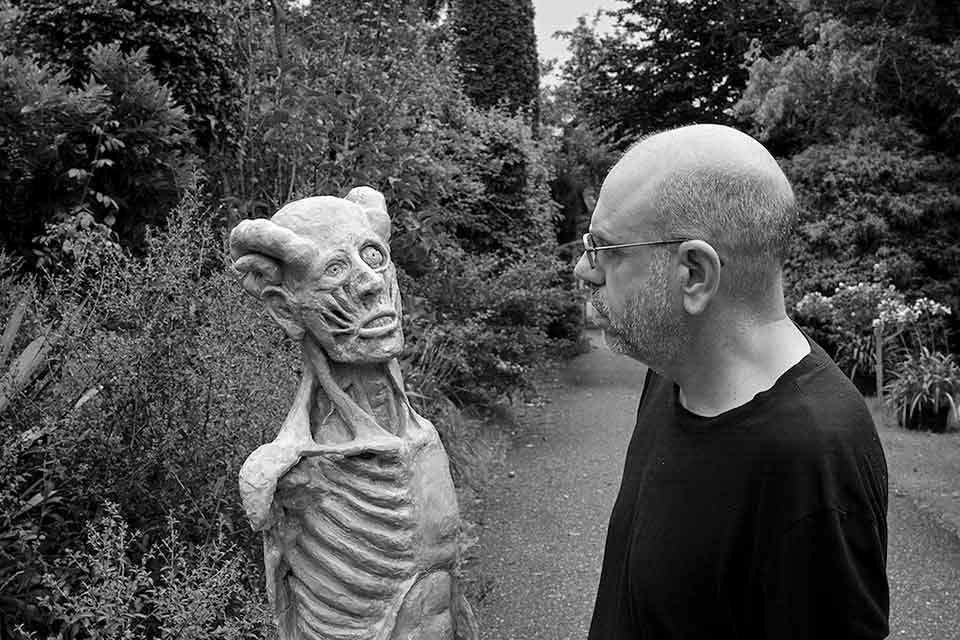
In 2019 I interviewed Dimitris Lyacos on the occasion of the US tour/launch of his trilogy, Poena Damni, which had been recently released in the English complete edition. When we met, he had just read for the inmates of a few Arizona prisons. He had also visited for the first time Los Angeles’s “Skid Row,” which reviewers of his work had compared, on occasion, to the setting of his second book, With the People from the Bridge. In the interview, we discussed his experience at the prisons as well as the impressions he gathered of Skid Row, which to him evoked a wall-less, plein-air, virtual form of incarceration. Less than a year later, Covid brought themes of virtual confinement to the forefront of our collective concern.
Lyacos’s new book, Until the Victim Becomes Our Own, is currently being translated into English, and I had the privilege of reading several excerpts. Some of them were variously connected to themes of reclusion, as perhaps I should have expected. Because Poena Damni begins with an evasion, a flight, and the new book was announced as the “zeroeth” volume of the trilogy, it seems natural for it to delve into the captivity that precedes the fugue. But echoes of captivity also permeate Poena Damni. They are, in fact, one of its leitmotifs.
Toti O’Brien: I believe the theme of captivity was already one of your focuses, but I wonder if the circumstances I mentioned (reading poetry in prisons in 2019, visiting Skid Row, the pandemic) might have influenced its development throughout the new book. Did they? If so, how?
Dimitris Lyacos: You are right, those circumstances fed into one another like a positive-feedback loop. My first experience of a prison reading, however, happened long ago, in 2002, at Wandsworth Prison in London. Although my recollection is rather hazy, I can tell you that the feeling of stepping in “an alien yet neighboring” world—as the title of our LARB interview goes—struck me deeply. Shorsha [Shorsha Sullivan is the English translator of Poena Damni ] and I got there with the first, almost imperceptible, grey morning glow; the room was still half-dark when we started the reading. I am thinking now that it is perhaps the same kind of light setting the scene for the opening passages of the trilogy.
This year, while working on section L of the new book, in which, among other things, an inmate dreams of a penal treadmill, I found out that Wandsworth was one of the places in which the so-called everlasting staircase was used to protect inmates from idleness and make them more productive. Oscar Wilde was subjected to it, right there, and he came out a broken man. Thankfully, in our time nobody needs to idly ascend seventeen thousand feet in one day at fifty-six steps per minute, and in that respect L is just informed by prison history. Captivity is still with us, however, envisaged as “the main and legitimate form of violence” meant to correct and reform our faulty souls.
In so far as Until the Victim Becomes Our Own addresses the evolution of violence, in its institutionalized forms as well as its protean metamorphoses, two consecutive sections of the book deal with incarceration from two different vantage points. L focuses on an inmate as part of the prison’s general population, and M is a take on SHU, the segregation housing unit—solitary confinement as a strategy intended to help the inmate turn an inward eye on himself, contemplate his acts, and self-correct. This is an almost religious view of incarceration, one akin to the model of a monk in its cell, left alone with himself and God and surrounded by a monastery, which, incidentally, sociologist Erving Goffman groups in the category of total institutions.
All that looks like the opposite of Skid Row, where everyone is on the move. But there is another form of seclusion there and a violence of a surreptitious kind. Against Foucault’s concept of disciplinary measures, here we are confronted with Deleuze’s concept of lack of access. In Skid Row, all may be on the move and technically free, but they have no key, no password, and in a world where all doors are open, but checked, that does not get them very far.
In Skid Row, all may be on the move and technically free, but they have no key, no password.
O’Brien: So the new book regards the evolution of violence in its various forms, incarceration being one of them. As I said, it was announced as the “zeroeth” volume of the trilogy, and I wonder if you could elaborate about this definition. Is it only chronological?
Lyacos: Z213: EXIT starts with a sentence of which the first part is missing: “these names and that’s how they found me.” Syntax-wise as well as plot-wise we are in medias res. There is a lingering doubt, right from the start. There are questions the reader is forced to neglect, and move on. The text pushes him forward, a little like the wind of history does the backward-looking Angel in Benjamin’s parable. Of course, we all move forward with our eyes turned to the past. The past is etched in our minds as we are proceeding, and we regularly stop to reassess our position, using the past as a frame of reference. That is what the “zeroeth” book is: a frame of reference. You have a man escaping or evading a “holding place” ambiguously described in the beginning of Z213: EXIT and recording in his diary the trail of his voyage.
But what was the world he left like? There is always a structure behind every escape or expulsion. Sometimes we call it a state, or a polity. There is a religious and ritual structure behind the scapegoat in Leviticus 16 that gives meaning to the act of expulsion. There is a structure behind the custom of pharmakos, in which two men were ushered around the streets of Athens with the purpose of cleansing the city from its miasmata and then stoned to death or thrown outside the city limits like a dirty sponge. Wouldn’t you wonder about the society that had invented such practices? Wouldn’t you want to explore what might be hidden from view, behind the books of Athens’s great poets and philosophers?
Say you are invited to dinner, you arrive and the table is set. A succulent piece of steak is served, a little blood oozes out of the tender meat. Has that piece become so alien to its “history” that you would never wonder about its past? If you did, how far back would you go? Certainly as far as the kitchen, that is easy to do, but how about what happened before? The slaughterhouse or, possibly, the gruesome life of the animal? There’s a story behind the little blood that you see, a residue hinting at the end of a life. A trace that has come to reach you, and you might want to follow the thread and think about life as part of a system—the prearranged context surrounding the chair you have sat on and the clean dish in which your dinner was served. In that simple sense, Until the Victim Becomes Our Own is a take on the growth of a system up to the “protagonist’s removal” from it, which is the starting point of the trilogy.
O’Brien: It addresses “what was before,” then, as well as “what is behind.” I recall that completing Poena Damni took you many decades, for various reasons. One of them, I believe, is your habit of devoting considerable time to tasks of preparation, reflection. Can you say a little about this modus operandi? What does the preparation imply? The new book seems to have been written more rapidly. How, or why, did the change of pace occur?
Lyacos: Somehow, this is about “confining” elements in a new ambient, bringing them close to each other and allowing them to interact. It’s about the formation of one complex, functional entity out of simpler, disparate parts—a soup of ideas, shards of texts, scraps of reality and the emotive glue that combines, breaks up, and recombines them. This “primordial soup,” however, has to be contained, and if you look at the case of abiogenesis, out of the trinity of elements that existed before the beginning of life—nucleic acids, proteins, and lipids—you could say lipids played the most important role. They provided the walls within which the elements would subsequently combine and evolve. To form your cell’s walls—to separate from the environment—takes time, but it is indispensable for any work to be done, and it took me some time to make sense of what should stay outside and what should be walled inside in order to come up with a working space, with a basic structure that would allow further development.
In the beginning, this was more of an open system. Things moved in and out. Eventually, the walls became more rigid, the set-up more stable, elements coalesced and settled in place. By and by, there was a well-defined space, a home, a place to work from, my metaphorical prison-cell-of-a-text that afforded only a lesser amount of revisions. I had moved toward order, and as it is easier to generate order from order than from the spontaneous disorder I had initially plunged in, more order came out of it. So, as the whole became more consistent and unified, I managed to produce more, and the new text, which is lengthier than the entire trilogy, came up in a short amount of time, at least by my own standards.
O’Brien: As you equate your writing process to the building of a complex, functional entity out of disconnected, disparate elements, I can’t help visualizing one of the excerpts of your new book, section O. It is written in the voice of a girl who, maybe alone, maybe abandoned, roams in a discharge-junkyard-demolition site. There, she builds a little dollhouse out of the trash she’s gleaning. I find this passage both lyrical and strikingly powerful. As she apparently builds a home for a toy, the girl accomplishes much more. She returns physical and emotional integrity, as well as temporal continuity, to a world that has disintegrated around her. She recovers the past through the materiality of the broken things she collects. Therefore, she can postulate a future. There’s a whimsicality within the tragedy. It is hard not to see Hansel and Gretel’s Candy House in contrast with the garbage-made hut. And yet, in a way, the girl turns into gold whatever she touches. Rather, her eyes and her hands transform death into life.
Would you like to comment on this passage? Mention some of the sources of inspiration? Some of the sparse elements that you gathered into this specific container? I deliberately employed the word “visualize” because this excerpt, in my sense, strongly evokes a scene by Bruegel or Bosch, or, to entirely change the context, a Rauschenberg collage. We are compelled to constantly shift our mind’s eye from random, chaotic general to carefully chosen particular, as the girl does, and that is exactly what happens before art that combines very rich ensembles with exquisitely defined detail. Is it just my reaction, or did you effectively have visual inspiration for these pages?
Lyacos: Here, again, we are talking about a process of separation and reconstitution. The girl finds herself immersed in a sea of objects, indistinguishable at first glance, and yet she perceives a lost order that must be regained. She wants every part to find its match, the world around her to be repaired. A kind of Tikun should make the shattered vessels of Tohu return to place—to remember Lurianic Kabbalah. All things long to return, and she does too, when she imagines her dad appearing and taking her home at the end of the section. Nevertheless, much work needs to be done before that can happen, all pieces must be first separated, identified, and, as part of this gradual rectification, the body, the doll’s body, the human body, has to be put back together as well.
All pieces must be first separated, identified, and, as part of this gradual rectification, the body, the doll’s body, the human body, has to be put back together as well.
You might think our girl isn’t the first one playing this game—in fact, our civilizations have played it many times in the past. Even prior to our sapiens beginnings, Neanderthals are claimed to have had a bear cult in which bones were reordered in meaningful positions inside caves. Also, wasn’t the body of a candidate shaman dismembered in the spirit world and then sewn back together with an iron wire? Apollo returned to Delphi carrying the members of Dionysus, who had been devoured by the Titans, to bury them there. If you look at the toys the girl chooses for her toy house, they are those the Titans had used to distract Dionysus so that they could capture him, “cone, and spinning-top, and limb-moving rattles.” And, most importantly, a mirror, which might recall Lacan’s mirror stage. The dislocated world is mirrored in the child’s psyche, but it is rectified in the drawing she makes in the end and will regain a new life. It doesn’t matter if she lacks the dexterity of a Bosch or a Brueghel, as it doesn’t matter that a lion’s mouth is not made to chew chaff, or that its instinct may not allow it to lie peacefully with its quarries. Isaiah did not mind that either, when he gave us his vision.
I am only pointing at a segment of reality, and indeed the visual part of the piece is real.
You may want to call this vision utopian—like some people call parts of my work dystopian. As far as I am concerned, I am only pointing at a segment of reality, and indeed the visual part of the piece is real. I walked in and out of it many times, while writing. It is a junkyard, less than two miles away from the ancient cemetery of Kerameikos, not too far from the Acropolis. There is a refugee camp there, and adjacent to it a dry tributary of Cephissus that you see covered in foliage and strewn with all kinds of things, and you walk by its side until you eventually come to the yard. Everything described in O is there: each object, the animals, the workers, and Pops too, that’s what everybody calls him, Pops, παππού, the man who runs the place from his humble little barrack like a benign god. Even the two beautiful white horses are there, living under the roof of a run-down industrial compound in the back of the yard, in the midst of the rising piles from our wrecked city’s armor. As the motto in The First Death goes—which some readers may have taken with a pinch of salt—“nothing in this book is original except perhaps by mistake.”
O’Brien: So the vision behind section O is, in fact, a sight of reality, tridimensional, pulsating and breathing. You have walked through the landscape that then transferred to your writing, as you have walked through Skid Row. Certainly, this must be part of the preparatory stage, the time during which the “container” for the text is built and elaborated. Being aware of your keen interest in the arts and music, I wonder if in addition to reality and, I imagine, to reading, you also draw inspiration from nonliterary forms of expression. If yes, would some in particular relate to the new book?
Lyacos: In relation to the new book I would hasten to say cinema, or rather a cinema-like editing, a way to place the pieces in meaningful sequence, but also to produce meaning from the interstitions. Not the kind of continuity editing, however, that promotes the line of the story. Rather a polymorphous, discontinuous kind, akin to Soviet montage. The “prison sections” we talked about, for instance, are placed next to each other as a case of tonal montage—they are glued together because of their common themes, so that emotion and meaning can be reinforced. Further afield comes the “slaughterhouse piece,” S, followed by T, the little girl’s prayer, in a sort of intellectual montage: the juxtaposition of two antithetical parts, with opposing forces joining to bring about a sense not separately present in either one.
I have tried to keep in check the length of each section, to make the cuts visible, create order and rhythm. Also, to arrange the parts in a way that gives definite direction to the meaning and emotions produced in the course of the reading experience. In the end, this concatenation should form a whole that will transcend the sum of its parts, a kind of horizon that, in its turn, will reflect back and enhance each individual section.
Order begets use, use begets meaning.
Obviously, our reception of language works the same way. Eisenstein was fully aware of this: change the order or remove a few parts and you get a different meaning, or no meaning at all. To underline the importance of directional sequence—and remain in the same setting—even a burnt-out light bulb had its value in the Soviet market. A state employee would buy it, bring it to the office, replace it and take the good one back home. The next morning, the janitor of the building would substitute it with a new one, keep the faulty one, and sell it to the next person, who would buy it and start yet another round. Each link plays its part in the chain, and the whole system works. Order begets use, use begets meaning. And new versions of order and meaning will always emerge as long as we keep reshuffling our footage. New merry-go-rounds, for as long as we are able to ride them—before we cast them out to the scrapyard and a naïve little girl comes along to put the pieces in place, making everything live together, and at peace.
August 2021
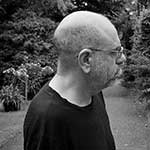 Dimitris Lyacos is the author of the Poena Damni trilogy (Z213: EXIT, With the People from the Bridge, The First Death). So far translated in twenty languages, the trilogy is one of the most widely acclaimed and best-selling works of contemporary European poetry. Poena Damni developed as a work in progress over the course of thirty years with subsequent editions and excerpts appearing in journals around the world, as well as in dialogue with a diverse range of sister projects it inspired. Renowned for combining, in a genre-defying form, themes from literary tradition with elements from ritual, religion, philosophy, and anthropology, the trilogy reexamines grand narratives in the context of some of the enduring motifs of the Western canon. New translations are due to appear in Brazil (Relicario) and Italy (Il Saggiatore) early in 2022.
Dimitris Lyacos is the author of the Poena Damni trilogy (Z213: EXIT, With the People from the Bridge, The First Death). So far translated in twenty languages, the trilogy is one of the most widely acclaimed and best-selling works of contemporary European poetry. Poena Damni developed as a work in progress over the course of thirty years with subsequent editions and excerpts appearing in journals around the world, as well as in dialogue with a diverse range of sister projects it inspired. Renowned for combining, in a genre-defying form, themes from literary tradition with elements from ritual, religion, philosophy, and anthropology, the trilogy reexamines grand narratives in the context of some of the enduring motifs of the Western canon. New translations are due to appear in Brazil (Relicario) and Italy (Il Saggiatore) early in 2022.

